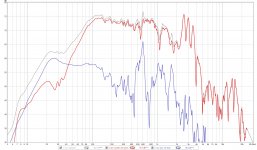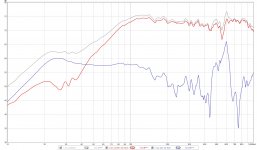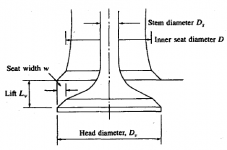Now I learned (-> Open Source Monkey Box) that I apparently used the right numbers, the manufacturer's numbers, for my corrections of the measurements. The graphs I posted should be right and the problem is still in in it's old margins which is not too flattering.
To isolate possible problems, we should look at the near field measurements of the woofer by itself, and the port by itself, with no DSP eq. Don't make any adjustments to the curves to 4-pi equivalent, just the raw curves.
Take a picture of your microphone setup when you measure the woofer and the port, and post it here. Remember that near field means center of the cone, about 1/4 inch away from the dust cap. Near field of the port means flush with the port rim.
Do you have the capability to measure the woofer Fs and Qts ?
Take a picture of your microphone setup when you measure the woofer and the port, and post it here. Remember that near field means center of the cone, about 1/4 inch away from the dust cap. Near field of the port means flush with the port rim.
Do you have the capability to measure the woofer Fs and Qts ?
For microphone positioning, I followed the rules Jeff Bagby stated in his white paper on quasi-anechoic measurements. This means lateral/vertical position is centred. On the depth axis: For port measurements, flush with the flange of the port. For woofer measurements, 1/10th the effective radiating surface diameter. I used 25 cm here as woofer effective surface, Matthias pointed out (-> Open Source Monkey Box), 26,2 cm (half the suspension) would have been even better. I positioned the microphone at the center of the dustcone and 2,5 cm away from it on z-axis. I will redo them another day, this is the same data as in my above graph:

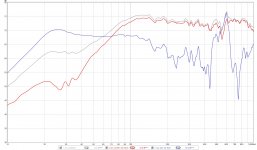
Also below with adjudsted SPL (-10,3 dB for port, based on vituixCAD Merger module calculation)
free air reference: https://faitalpro.com/products/files/12PR320/8/12PR320_response_8.gif


Also below with adjudsted SPL (-10,3 dB for port, based on vituixCAD Merger module calculation)
free air reference: https://faitalpro.com/products/files/12PR320/8/12PR320_response_8.gif
Attachments
Last edited:
That's hell of a port resonance you've got there. Too small volume combined with pretty low port tuning.
Yes, there is no damping yet, only bare chipboard sheets. I will get some lining material soon and when IKEA reopens some polyester pillows. First, I would like to sort out the BSC and tuning, which is happening at center 190 and below. But when I come to the port problem, I will have other questions. With dual ports, slightly higher tuned, I could shift port resonance center from 600 to 370. I will like to discuss whether this is useful.
Also I will check for a leak before I remeasure.
Also I will check for a leak before I remeasure.
Last edited:
your near field measurements are showing a significant mismatch to the T/S model. It is possible your woofers have a higher Fs than spec, or a lower Qts than spec, or (most likely) both.
The solution is probably going to be a higher tuning frequency Fb. If you do not have the capability of measuring the T/S parameters of your drivers, then you will have to experiment.
Your 600 Hz port resonance may not be much of a problem once you install acoustical damping material.
The solution is probably going to be a higher tuning frequency Fb. If you do not have the capability of measuring the T/S parameters of your drivers, then you will have to experiment.
Your 600 Hz port resonance may not be much of a problem once you install acoustical damping material.
Last edited:
I sealed the front panel with some acrylic and canibalized a pillow to add some damping, then remeasured. There might be some differences because of the added damping material. The general results are similar, but the vent is more effective now.
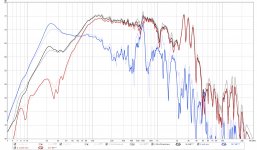
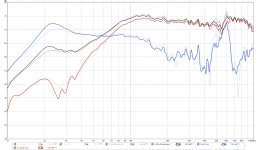
I would not know how I can measure T/S because the amp is connected to the drivers inside the box. I also never did this before. But prior experience showed that Faital gives correct data on their drivers (Open Source Monkey Box-thread had measurements). Why should it be T/S, could it be other reasons?
These measurements are in a 50 liter box, not a norm baffle, and vent was thought to be tuned to 31,2 Hz. The port output peak seams lower than what WinISD simulates. Could it also be a cancellation or how can this happen (-8 Hz)? Do I have to run the driver at high power? I use relatively low volume so to not annoy the neighbours.
Here are WinISD simulations for 50 liters, one with the vent tunig according to vent length (25 cm/31,2 Herz), one according to vent peak (23 Hz) of the measurement. If I would set the base from where f3 is defined at 73 dB SPL (ignoring the slight peak), the 23 Hz measurement would agree with the simulation quite well:
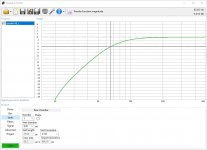
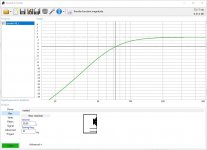
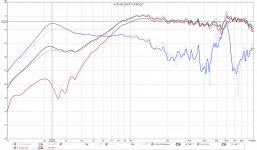
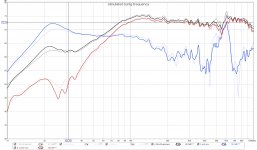
But 31,2 tuning does not make too much sense. Can it be that the vent itself is ineffective?


I would not know how I can measure T/S because the amp is connected to the drivers inside the box. I also never did this before. But prior experience showed that Faital gives correct data on their drivers (Open Source Monkey Box-thread had measurements). Why should it be T/S, could it be other reasons?
These measurements are in a 50 liter box, not a norm baffle, and vent was thought to be tuned to 31,2 Hz. The port output peak seams lower than what WinISD simulates. Could it also be a cancellation or how can this happen (-8 Hz)? Do I have to run the driver at high power? I use relatively low volume so to not annoy the neighbours.
Here are WinISD simulations for 50 liters, one with the vent tunig according to vent length (25 cm/31,2 Herz), one according to vent peak (23 Hz) of the measurement. If I would set the base from where f3 is defined at 73 dB SPL (ignoring the slight peak), the 23 Hz measurement would agree with the simulation quite well:




But 31,2 tuning does not make too much sense. Can it be that the vent itself is ineffective?
Last edited:
Diggin deeper into the vent direction:
In another way one could say the Visaton BR25.50, here the representations given by the manufacturer
https://www.visaton.de/sites/default/files/dd_product/br25_50.jpg
https://www.visaton.de/sites/default/files/dd_product/br25_50_tz.GIF,
said to be 25 cm long (not so easy to measure because of ellbow), diameter defenitely 8 cm, behaves as if it was twice as long: WinISD gives a length of 51 cm for a vent with a tunig at 23 Hz in a box of 50 liters and a surface of 50 sq cm/8 cm diameter. The vent would then overperform due to some reasons unnown.
But although port output peak is significantly lower and mismatches length/surface-prediction, the position of 1st port resonance at 600 Hz which can easily be observed in the real measurements strictly agree with what the calculation supposes:
F1 = c/(2*L+0.8*d)
C = speed of sound (m/s)
L = vent length (m)
d = vend diameter (m)
= 343/(2*0,25+0,8*0,08)
= 608 Hz.
Adding this: I have found out that Visaton is kindly complying a certain postal tube standard (80mm) and I can easily use a mailing tube to experiment with vent lenghts. At least until 65 cm of tubing is used and cut up.
In another way one could say the Visaton BR25.50, here the representations given by the manufacturer
https://www.visaton.de/sites/default/files/dd_product/br25_50.jpg
https://www.visaton.de/sites/default/files/dd_product/br25_50_tz.GIF,
said to be 25 cm long (not so easy to measure because of ellbow), diameter defenitely 8 cm, behaves as if it was twice as long: WinISD gives a length of 51 cm for a vent with a tunig at 23 Hz in a box of 50 liters and a surface of 50 sq cm/8 cm diameter. The vent would then overperform due to some reasons unnown.
But although port output peak is significantly lower and mismatches length/surface-prediction, the position of 1st port resonance at 600 Hz which can easily be observed in the real measurements strictly agree with what the calculation supposes:
F1 = c/(2*L+0.8*d)
C = speed of sound (m/s)
L = vent length (m)
d = vend diameter (m)
= 343/(2*0,25+0,8*0,08)
= 608 Hz.
Adding this: I have found out that Visaton is kindly complying a certain postal tube standard (80mm) and I can easily use a mailing tube to experiment with vent lenghts. At least until 65 cm of tubing is used and cut up.
Last edited:
Here are images of the measurement setup, also the stuffing applied to the box for the last measurement.
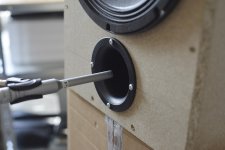
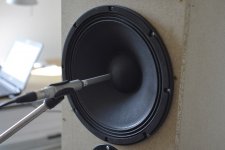
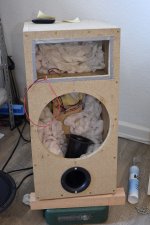
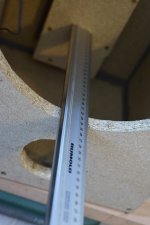
I further followed my question if the vent is not performing right and turned another direction. If the vent peak output is performing at a frequency (23 Hz it seams from the measurement) that in a box of 50 liters volume would take a vent twice as long (51 cm), is the real volume of the box as presented to the vent/driver only half it's actual size? So I kept the tuning frequency which would results from vent manufacturer data (25cm and 8 cm diameter) in the given box size, which is 31,2 Hz and dialed in the numbers in WinISD until I the vent length was 51 cm. I found a volume of 27,4 liters to match this parameters:
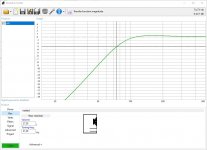
This would be even less than the compartment under the bracing, sans the space around the plate amp box, which is aquivalent of 31,4 liters:
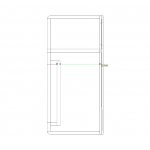
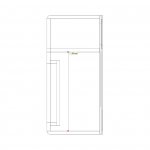
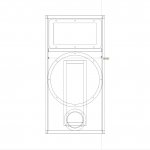
I really do not get it.




I further followed my question if the vent is not performing right and turned another direction. If the vent peak output is performing at a frequency (23 Hz it seams from the measurement) that in a box of 50 liters volume would take a vent twice as long (51 cm), is the real volume of the box as presented to the vent/driver only half it's actual size? So I kept the tuning frequency which would results from vent manufacturer data (25cm and 8 cm diameter) in the given box size, which is 31,2 Hz and dialed in the numbers in WinISD until I the vent length was 51 cm. I found a volume of 27,4 liters to match this parameters:

This would be even less than the compartment under the bracing, sans the space around the plate amp box, which is aquivalent of 31,4 liters:



I really do not get it.
Last edited:
when i asked you about T/S parameters, I had not noticed that the vent Fb was way down at 23 Hz. I think you have found the culprit, or one of them anyway.
So why is your 25 cm vent acting like a much longer vent?
On the inside of the box, how close is the vent to other surfaces, like the cabinet bottom and the amp box? If it is within 1 diameter from a surface, that surface could be adding some effective length to the vent. I assume the elbow positions the vent away from surfaces, yes?
The fact that your simulation with 23 Hz matches measured performance is good news. It means that if you tune the vent to 31 Hz, this should also match the simulation.
So why is your 25 cm vent acting like a much longer vent?
On the inside of the box, how close is the vent to other surfaces, like the cabinet bottom and the amp box? If it is within 1 diameter from a surface, that surface could be adding some effective length to the vent. I assume the elbow positions the vent away from surfaces, yes?
The fact that your simulation with 23 Hz matches measured performance is good news. It means that if you tune the vent to 31 Hz, this should also match the simulation.
Does the direction of a vent not play a role but only the distance to a surface?
According to Visaton (https://www.visaton.de/sites/default/files/dd_product/br25_50_tz.GIF) the depth of this elbow-vent is 20,5 cm and the ruler (https://www.diyaudio.com/forums/attachments/multi-way/943489d1618692936-digital-bsc-question-2-jpg) shows baffle front to plate amp box is roughly 24 cm. The flange should be 4 cm away from the backface of the plate amp box, and pointing upwards with a 10 degree angle toward the backplate, as shown on this image: https://www.diyaudio.com/forums/attachments/multi-way/943488d1618692936-digital-bsc-question-1-jpg I thought this would be okay. I learned the distance of a vent from a surface should roughly be its diameter, but this rule would apply to vents which are directed towards the surface. And an elbow would precisely be a solution to not compromise port performance. Was I wrong?
According to Visaton (https://www.visaton.de/sites/default/files/dd_product/br25_50_tz.GIF) the depth of this elbow-vent is 20,5 cm and the ruler (https://www.diyaudio.com/forums/attachments/multi-way/943489d1618692936-digital-bsc-question-2-jpg) shows baffle front to plate amp box is roughly 24 cm. The flange should be 4 cm away from the backface of the plate amp box, and pointing upwards with a 10 degree angle toward the backplate, as shown on this image: https://www.diyaudio.com/forums/attachments/multi-way/943488d1618692936-digital-bsc-question-1-jpg I thought this would be okay. I learned the distance of a vent from a surface should roughly be its diameter, but this rule would apply to vents which are directed towards the surface. And an elbow would precisely be a solution to not compromise port performance. Was I wrong?
I have never used an elbow in a vented box, so I do not speak from experience. It sure seems that 4 cm should be enough clearance, but I really do not know.
Anywhere near the sides can make a difference, it may not be as much as it seems. If you look at this automotive port the exit appears more restricted than it is.
For example, the cross-sectional area of a 5cm port is around 20cm2, but the area of the exit if it faces a wall 4cm away (pi x circumference x 4cm) is triple that. These things can be allowed to happen, eg reflected energy from a change in direction, or a minor restriction.
However it's best to measure the tuning.
For example, the cross-sectional area of a 5cm port is around 20cm2, but the area of the exit if it faces a wall 4cm away (pi x circumference x 4cm) is triple that. These things can be allowed to happen, eg reflected energy from a change in direction, or a minor restriction.
However it's best to measure the tuning.
Attachments
The vent is working where it should by the way. I will find out about the way to do impedance measurements with a plate amp some time. This would have safed me the confusion of the vent peak SPL with vent tuning. When I simulated in vituixCAD, I understood this when I saw the graph. Soon i will do some remeasurements some new graphs. But actually some time, a vent is up to 100 percent of, see here: vent tuning
A DATS v3 can make very accurate impedance measurements of your drivers, bypassing the plate amp.
Dayton Audio DATS V3 Computer Based Speaker & Audio Component Test System
I find mine very useful.
Dayton Audio DATS V3 Computer Based Speaker & Audio Component Test System
I find mine very useful.
Jim. Many of us would check tuning with just some resistors and REW, or equivalent. Is DATS the one that leads to people getting the microphone that won't do timing?
DATS is not the dreaded OmniMic... It has two test leads. Connect it to a driver and it spits out an impedance curve, a *.zma file, Fs, Qes, Qts. With a little extra work it will calculate Vas.
I could not bring up impedance measuring yet. But I have continued with some measurements, because the uneven bass response was bothering me and I wanted to find out what is the magnitude of this misalignment and if I can better the causes before I continue to the real speaker or if it is a non-issue.
I had sorted out the vent as a source, because it is working were it ought to be, at ~ 32 Hertz, where it is simulated to work at 31,2 given a 50 liter enclosure and its length of 25 cm, diameter 8 cm. Checked against with WinISD, this means if length/diameter and observed tuning frequency are set as fixed, the vent does see 47,5 liters of the 50 liters. That would be okay I assume. The location of the first port resonance at 600 Hz fits the numbers well. For the new measurements I used higher volumes to get better data. I had to change mic gain and that is why it is not all too obvious from the new charts. But it was substantially louder. Now it is also much easier to locate vent tuning frequency:
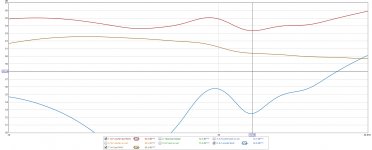
But I do not really understand yet what the woofer is doing. Here is it's response on a norm baffle. It shows a small ditch between 300 and 400 Hertz and a likewise smallish peak between 500 and 600, but it is essentially flat within a few dB between 150 to 1 kHz:
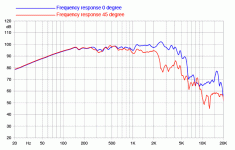
Now this is how I measure the FaitalPro 12PR320 in a 50 liter box with a vent tuned around 32 Hz. No additional filters, just power. One could assume there is a tilt and the response between 80-150 Hertz is elevated. This is normally a sign of a way too small box The alternative to a boxy response would be that some cancellations of the vent response cause the response between 200 to 600 Hz to dive:
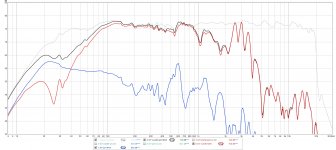
To tight and boxy also has some evidence if one compares the response of the assisted box (PEQ boost of 10 dB at 36 Hz) as is in my current filter setup. Only when in WinISD the volume is reduced to about 40 liters the contour of the s-curve in the measurements show up more clearly in simulation, while at 50 liters, it suggest a pretty flat response:
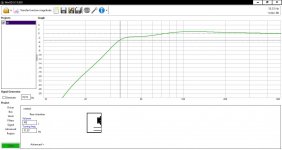
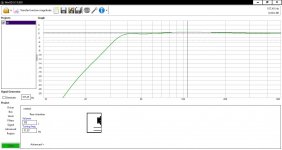
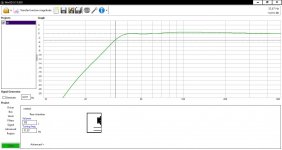
My current setup of filters has this PEQ and some shaping >150 Hz to flatten it out. Below 150, the response is dominated by the conjunction of vent tuning, box volume, woofer performance and PEQ assist. If the peak in bass at around 115 Hz would be set as 0 dB, bass response is sacking fast -2 dB and plateaus there before it falls to the simulated f3. This sacking is not seen in WinISD with 50 liters. Why does it happen?
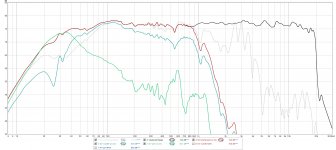
If I set the target from where f3 is calculated at 200 Hz and 76,5 dB, in this set of measurements, it is still a very good result, albeit not as straight as simulated. If this is the defined level where the speaker is adjusted to, the following parameters define the box performance and what I can achieve with my current filters:
The performance of the woofer has been measured before and it was assumed that manufacturer data is okay: https://www.diyaudio.com/forums/multi-way/327594-source-monkey-box-5.html#post5586614 Since then, Faital seems to have corrected Vas from 94 to 113, although here, it was measured as 91 liters. So what is there to be optimized or should I leave it as is? The vent seems to work with 47,2 liters, which is good. Only I would love to straighten out the bass response. But is it even possible? What do I have to check to see if it is possible to get a more neutral response out of this box?
They do sound very nice already!
I had sorted out the vent as a source, because it is working were it ought to be, at ~ 32 Hertz, where it is simulated to work at 31,2 given a 50 liter enclosure and its length of 25 cm, diameter 8 cm. Checked against with WinISD, this means if length/diameter and observed tuning frequency are set as fixed, the vent does see 47,5 liters of the 50 liters. That would be okay I assume. The location of the first port resonance at 600 Hz fits the numbers well. For the new measurements I used higher volumes to get better data. I had to change mic gain and that is why it is not all too obvious from the new charts. But it was substantially louder. Now it is also much easier to locate vent tuning frequency:

But I do not really understand yet what the woofer is doing. Here is it's response on a norm baffle. It shows a small ditch between 300 and 400 Hertz and a likewise smallish peak between 500 and 600, but it is essentially flat within a few dB between 150 to 1 kHz:

Now this is how I measure the FaitalPro 12PR320 in a 50 liter box with a vent tuned around 32 Hz. No additional filters, just power. One could assume there is a tilt and the response between 80-150 Hertz is elevated. This is normally a sign of a way too small box The alternative to a boxy response would be that some cancellations of the vent response cause the response between 200 to 600 Hz to dive:

To tight and boxy also has some evidence if one compares the response of the assisted box (PEQ boost of 10 dB at 36 Hz) as is in my current filter setup. Only when in WinISD the volume is reduced to about 40 liters the contour of the s-curve in the measurements show up more clearly in simulation, while at 50 liters, it suggest a pretty flat response:



My current setup of filters has this PEQ and some shaping >150 Hz to flatten it out. Below 150, the response is dominated by the conjunction of vent tuning, box volume, woofer performance and PEQ assist. If the peak in bass at around 115 Hz would be set as 0 dB, bass response is sacking fast -2 dB and plateaus there before it falls to the simulated f3. This sacking is not seen in WinISD with 50 liters. Why does it happen?

If I set the target from where f3 is calculated at 200 Hz and 76,5 dB, in this set of measurements, it is still a very good result, albeit not as straight as simulated. If this is the defined level where the speaker is adjusted to, the following parameters define the box performance and what I can achieve with my current filters:
Code:
no filters:
90-200 Hz: +1-1,3 dB
f3: 71 Hz
f6: 56,5
f10: 41,5
Code:
filters:
80-150: +1,5 dB
40-80 Hz: -1,5 dB, at 60 Hz: -1,8 dB
f3: 33,3 Hz
f6: 27 Hz
f10: 25,8They do sound very nice already!
Last edited:
- Home
- Loudspeakers
- Multi-Way
- Digital BSC question
